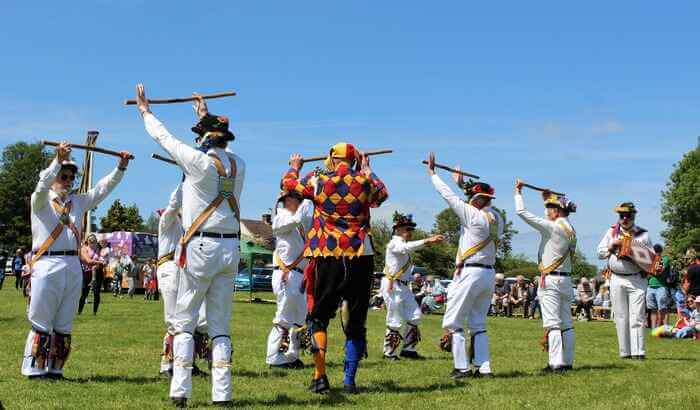OAK APPLE DAY IN GREAT WISHFORD - GROVELY, GROVELY, GROVELY, AND ALL GROVELY!
- Sarah
- May 30, 2023
- 5 min read
The 29th of May is a special occasion for the places across the country who celebrate Oak Apple Day. In Great Wishford, just north of Salisbury in Wiltshire, this takes the form of claiming the continuation of the ancient rights of villagers to collect wood from nearby Grovely Woods. The day is celebrated by the villagers with an early start to collect the wood, a short service at Salisbury Cathedral to re-instate their rights and is followed with a parade and fete in the village.

For most of the UK, Oak Apple Day, also known as Restoration Day, is a yearly celebration to commemorate the restoration of Charles II to the throne in 1660. On that day, which was his 30th birthday, the King rode into London in triumph to reclaim his throne. The day is named Oak Apple in memory of the time when the King hid from the pursuing Roundheads in an oak tree (there appear to be many of them on his route to the coast) following his escape from the Battle of Worcester in 1651 to exile in France.
In Northampton a garland is laid on Charles II’s statue each year as grateful thanks for the gift of timber from royal forests after a great fire in the city. At St Neot in Cornwall the old oak is thrown down from the top of the church tower before a new bough is blessed and hauled up to the top by villagers. In London at the Royal Hospital Chelsea, the day is observed as Founder's Day, as it was Charles II who founded the hospital for retired servicemen in 1681.
Oak Apple Day used to be a public holiday, recognised across the country, with many monarchists wearing a sprig of oak leaves as a statement of loyalty to the crown. However, the day was formally abolished under the 1859 Anniversary Days Observance Act and in many places the traditions associated with it have died out.
Not so in Great Wishford, a small and very picturesque village just five miles north of Salisbury. It is located just to the east of Grovely Woods, one of the largest tracts of forest in Wiltshire which stands on a chalk ridge over the River Wylye. The woods were once part of a large hunting forest and had belonged to Wilton Abbey. In 1541 with the Dissolution of the Monasteries, Henry VIII gave the land to the 1st Earl of Pembroke and it is still owned by the Earl of Pembroke (we are currently on the 18th) who lives in the very stately Wilton House.

The villagers of Great Wishford were granted rights - to collect fallen branches from the Earl of Pembroke’s Grovely Woods throughout the year, to collect live boughs “no thicker than a man’s forearm” on Oak Apple Day itself and to pasture cattle and allow pigs to root. These rights are believed to have been in operation from the 12th century but were actually enshrined in law in a Charter of the Forest Court of Grovely in 1603.
The villagers have been forced to legally protect their wood rights at courts in 1292, 1318, 1332 and 1825 from various landowners who were keen to prevent them access to Grovely Woods so that they could use the wood exclusively, probably for hunting.

The day begins at 5.30am (it used to be much earlier), with about 30 villagers going round the village to wake up all sleepers. They bang pots and pans to make as much noise as they can, to get all of the residents awake and up, as the right to collect live boughs is only for the 29th May, so all residents are needed up on the wooded hillside for as long a time as possible, to collect the maximum amount of wood for their winter fires and construction needs before darkness.
Boughs are collected with which to decorate houses and a large bough of oak (the Marriage Bough) is hoisted up the tower of St Giles Church, said to give good luck to anyone married there. The most prized boughs are those covered with oak apples, which are not apples but actually gall from the oak apple gall wasp.
These days breakfast is then served at the local pub, The Royal Oak, before many of the community head to Salisbury Cathedral to receive God’s blessing on their claims. Wearing sprigs of oak leaves in lapels, they gather to watch the ceremony. It begins outside the cathedral on the lawns when four dancers in 18th century costume, carrying their claimed oak apple boughs, process towards the building under the banner proclaiming “Grovely! Grovely! Grovely! And All Grovely! Unity is Strength”.
The name 'Grovely' only appears twice in the Charter and it was said that the third was added at the start of the 20th century, when a villager was asked how much of Grovely the villagers claimed a right to. His reply was ‘just three thirds and no more’.
The dancers then perform the Nitch Dance outside the cathedral door under the watch of a member of the clergy, accompanied by a harmonium. The dance is said to be in memory of Grace Read of nearby village, Barford St Martin, and her three companions, who were arrested and imprisoned in 1825 after taking wood from Grovely. (Nitches are the bundles of dry wood that they carry.) They perform two traditional dances, one holding their oak boughs, and the other around a pile of them.
The villagers then move into the Chancel of the cathedral to hear a Canon of the Cathedral read from the 17th charter in acknowledgement of their rights, and pronounce his blessing to the villagers and assembled congregation. The villagers then shout in unison “Grovely! Grovely! Grovely! And All Grovely!” to conclude the event, a strangely evocative and almost primeval cry. Meanwhile, assorted and disbelieving tourists look on in amazement at such totally bizarre procedures.
At midday there is a parade of villagers through the streets of Great Wishford, carrying their oak boughs to beat the bounds of the village. Led by a fire engine, the banner and the Nitch ladies walk holding the oak boughs on their heads, they are followed by groups of Morris Dancers, a May King and Queen, a series of very old tractors, local children carrying their artwork and anyone else who wants to get involved. After walking around the village, they go to the Oak Apple Field, which then opens to begin the annual celebration fete.
The fete incorporates many traditional and quirky English customs. There are competitions such as £50 for the best scarecrow in a garden, and a Cup for the “best dressed” house. There is a BBQ and a bar which does a thriving trade, as well as various stalls selling knick knacks, cakes and locally produced goods. The Nitch Ladies dance again, as do the Morris Dancers, and anyone who wants to gets to have a go at traditional maypole dancing. Typical fete entertainments are provided including Punch and Judy, Swing Boats and horseshoe throwing as well as more modern activities like face painting and hair braiding. The day ends with live music in the marquee.

The ceremony has changed in varying degrees over the centuries, with small alterations here and there, but thank goodness that villages like Great Wishford can keep the past and its traditions alive, albeit in a modern form.
Visiting Oak Apple Day at Great Wishford
Follow the Oak Apple Club on Facebook for details. The early morning part is for villagers only but you can watch the Nitch Dance and Procession at Salisbury Cathedral and join the villagers for the parade and fete afterwards. Parking is provided in Oak Apple Field and the fete costs £2 per person to enter.





















Comments